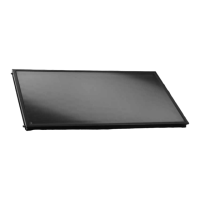5 x Control unit operation
48
FA ROTEX Solaris - 08/2007
For indirect monitoring of the flow rate, it is important to observe the system temperatures during normal operation. Under
optimum solar radiation conditions (cloudless sky, clear air, Sun about vertical to the solar panel surface), the temperature
increase in the solar panel should be about 10 to 15 Kelvin. During operation of pump P1 and with a return flow temperature of
e.g. 50°C, the solar panel temperature should be about 60 to 65°C. If a calorimeter is installed, the flow rate can be adjusted
by means of a direct measurement while operating a pump.
Tab. 5-5 Setting the flow rate of the FlowGuard (FLG)
5.4.3 Recommended settings for auxiliary heating via external heat sources or the electric heater, burner
inhibit contact
For the highest performance potential:
• Rarely with Sanicube Solaris and only up to an adequate temperature, by means of an external heat source or the electric
heater.
• Via a timer program for "normal use", with optimal times determined from observing regular consumption behaviour.
• Supplementary charging, depending on the connected heat source, enabled one or two hours before the accustomed
consumption time.
• The charging time should be limited so that the storage tank does not need to be directly heated after a normal consumption
cycle.
The optimum charging temperature depends on personal needs; frequently a storage tank temperature of 50°C is adequate. An
average shower requires about 30 to 50 l of hot water with an outlet temperature of 40°C. The cold water entering the storage
tank during the shower must be heated in the Sanicube Solaris using the flow heater principle.
• With larger amounts of hot water and to ensure the required convenience also during unaccustomed consumption times, the
temperature in the hot water section must be sufficiently high, or the heat source for charging must be enabled, e.g. by
switching to a different timer program.
Heating by means of an external heat generator
Depending on heating requirements (related to the building's insulation standard, outdoor temperature and desired room
temperatures) and the installed solar panel surface, it might be significant to disable the external heat generator by fitting a burner
inhibit contact. For this purpose, even when the heater control demands additional heat:
• Adjust the operating parameters "P min" and "TS min" (see Section 5.3.7) so that the external generator does not supply
heat,
– if the solar panels are supplying a minimum amount of heat, or
– the storage tank has reached a sufficiently high temperature.
Number of solar panels Desired flow in l/min Desired flow in l/h
2 3.0 to 4.0 180 to 240
3 4.5 to 6.0 270 to 360
4 6.0 to 8.0 360 to 480
5 7.5 to 10.0 450 to 600
To ensure fast and safe filling of the system, the booster pump P2 should always be operated in stage 3.
If possible, the circulation pump P1 should be operated at a lower speed, it the system height H (height
difference between mounting floor level of the Sanicube Solaris and the upper solar panel edge) is not more
than 10 m (for stage 2) or 8 m (for stage 1) and the flow rate is still sufficient.
Even if the flow rate and the switch-on difference "Delta T On", have been adjusted correctly and the weather
conditions are ideal, the Solaris system sometimes switches off. With a rising or setting Sun and an increasing
storage tank temperature, the solar panel temperature gradually falls after the pumps have been switched on,
i.e. the switch-off conditions are met. Due to the continued solar radiation, the solar panel temperature
increases again, the pumps are started and the system clocks because the solar radiation is insufficient for
continuous operation. The FlowSensor reduces this effect by regulating the pump speed.

